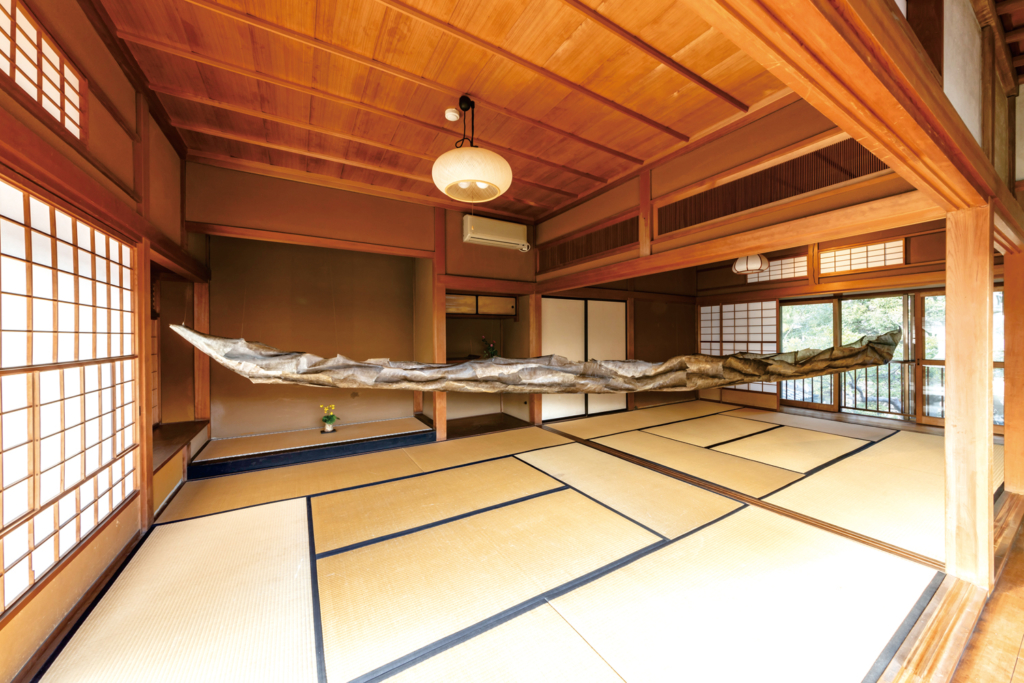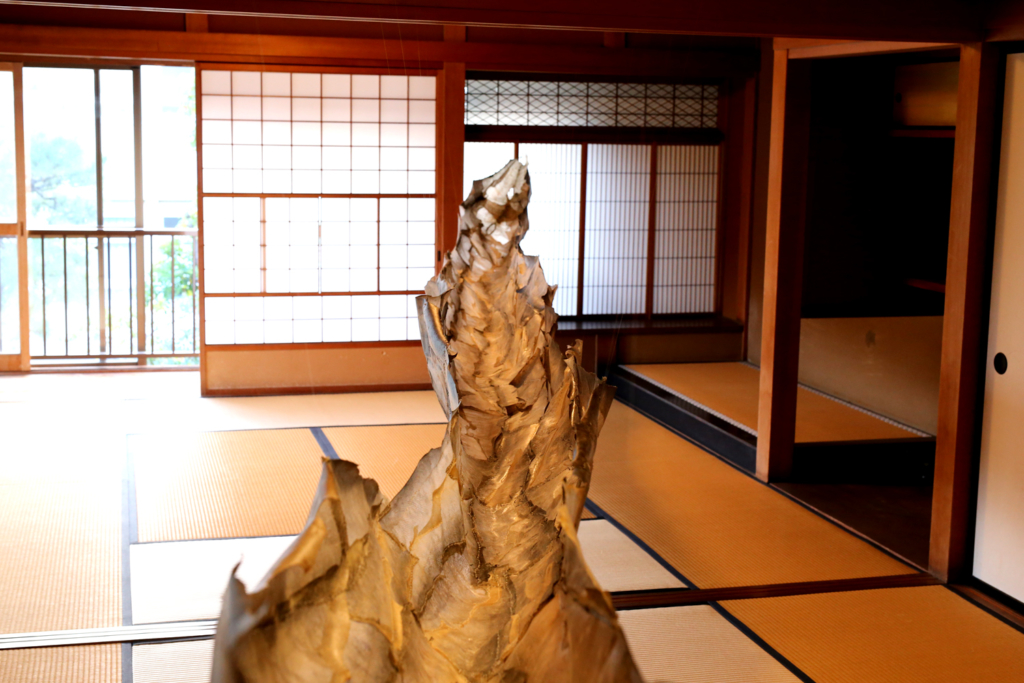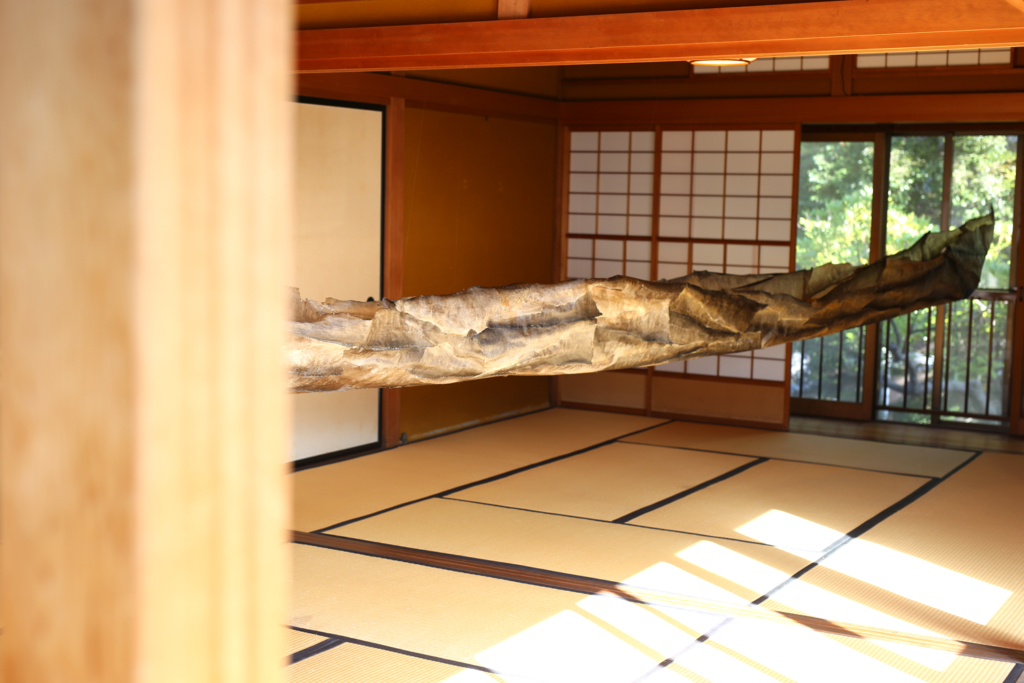Photo by Nakamura Osamu / 中村脩
鮭皮の舟-シナヌ、マラプト・ネ / 杉原信幸×中村綾花
鮭皮、ロウ引き綿麻糸、釣り糸 / H0.8m×W0.5m×D8m / ゆいぽーと2020秋季AIR招聘プログラム / 砂丘館 / 2020年
太古シナヌと呼ばれた信濃の国からやってきた作家は、長野県では千曲川と呼ばれる信濃川で繋がる新潟市のゆいぽーとに3か月間滞在し、信濃川の痕跡を遡上するように、縄文文化と土地の歴史、民俗のリサーチを行いました。今回、縄文土器の表現の中で最も優れた造形性を持つ火炎型土器の造形は平安時代には数万匹の鮭が遡上していたという信濃川の川面を跳ねる鮭の姿ではないかという直感をもとに、その豊かな恵みをもたらす鮭の皮を用いて、舟を作りました。海から、生まれた川へと帰ってくる鮭の婚姻色は炎のように赤いです。
火焔型土器の造形は信濃川の水紋と遡上する鮭に対する祈りと感謝の造形であり、アイヌの人たちの頂いた命を送りかえし、再び帰ってきてもらうための儀式としての、もの送りは縄文の人たちの感性と繋がっています。アイヌの人たちは、鮭皮で靴や魚衣服を作ります。そしてイオマンテ(熊送り)で送られる仔熊の霊は、 神々の世界に帰った後も人間の集落で大切に育てられ、もてなされたことを忘れず、 再び土産として肉と毛皮を纏って、人間の世界に戻ってきてくれると信じられてきました。それは、アイヌ語では「マラプト・ネ(賓客になる)」と表現されます。一年に一度海を越えて訪れる来訪神のことを「まれびと」と呼びます。「まれびと」という概念も鮭と関係があるように思います。そこには秋になると肉と皮を纏って信濃川に還ってくる鮭の姿に重なります。鮭は大自然に対する根源的な感謝を生み、贈与という縄文人-アイヌ-日本人の心性の深い部分を作り出した重要な存在ではなかったのか、わたしたちは、自然をコントロールできるようになったと思いこみ、鮭という存在の大きさを忘れてしまったのではないでしょうか。
聖籠の鮭加工工場から頂いた新潟の鮭皮と、信濃漁業協同組合から頂いた信濃川を遡上した鮭を毎日、さばいて、肉を剥いて、竹べらで落とし、新潟の海岸で拾った軽石で内皮を剥ぎ、アムール川流域の魚衣服制作の方法を調べたなめし液につけて、鮭皮を綺麗に磨き上げていく、生の痕跡を洗い流し、皮を革にする過程で、身づくろいをするような、命に対する感謝と慈しみの感覚が生まれてくるような気がします。それを手縫いで縫い合わせ、頂いた鮭を実際に食べてみると、太古の人の実感がかすかに伝わってくるような気がしました。
それは鮭皮で舟をつくることで、もの送りの舟としてのいのちのアニミズムを感じることです。荒れ狂う洪水ももたらした信濃川は、同時に肥沃な大地を運び、破壊と創造を繰り返しました。鮭加工工場の人の手が加工した鮭皮の形をそのまま縫い合わせることで浮かび上がってくる形は文様のようです。信濃川を育む豊かな山なみようなの景色が水墨画のように鮭皮の舟に浮かび上がります。そして鮭皮の舟は信濃川の流れのように続いていく再生への祈りの造形です。それは信濃川に溢れるように鮭が遡上した太古の記憶を呼び覚まします。
協力 砂丘館、信濃川漁業協同組合、近藤商店株式会社
Photo by 中村脩
The Ship of Salmon Skins – Shinano, marapto-ne / Sugihara Nobuyuki x Nakamura Ayaka
Salmon skin, waxed cotton linen thread, fishing line / H0.8m×W0.5m×D8m / YUI-PORT 2020 Autumn AIR Invitation Program / Sakyukan / Niigata / 2020
We stayed at YUI-PORT in Niigata City, which is connected by the Shinano River called the Chikuma River in the Shinano country called Shinanu in ancient times, for three months, and we researched the history of the land, folklore and the Jomon culture as if tracing the Shinano River. The intuition that the flame-type pottery, which has the best creativity in the expression of Jomon pottery, is the appearance of salmon jumping on the surface of the Shinano River, where tens of thousands of salmon were running up during the Heian period (about 1000 years ago). Based on this, we made a boat using salmon skins that brings about its rich blessings. The marital color of salmon returning to the river born from the sea is fiery red.
The “Mono-Okuri” ritual, in which the Ainu people send back the lives they ate and return them again, is linked to the sensibility of the Jomon people. Ainu people make shoes and fish clothes from salmon skin. Ainu people believed that even after the bear were eaten by the Ainu people and returned to the world of the gods, the spirit of the baby bear sent off by Iomante ritual (sending off the bear) will return to the human world again as a souvenir wearing meat and fur, without forgetting that it was carefully raised and hospitalized in the Ainu village. It is expressed in Ainu as “marapto-ne (Become honored guests)”. A visiting god who visits across the sea once a year is called “Marebito” in Japan. I think the concept of “Marebito” is also related to salmon. It overlaps with the appearance of salmon returning to the Shinano River in autumn, wearing meat and skin. I think that salmon is an important existence that has created a fundamental appreciation for nature and created a deep part of the Jomon-Ainu-Japanese spirit of gifting. Perhaps we misunderstood that we could control nature and forgot the importance of the existence of salmon.
We cleaned the salmon skin of Niigata from the salmon processing factory in Seiro and the salmon that went up the Shinano River from the Shinano Fisheries Cooperative every day.
We stripped the meat, dropped it with a bamboo spatula, and stripped the endothelium with pumice stones picked up on the coast of Niigata. And we soaked the salmon skin in a tanning solution that investigated how to make fish clothes in the Amur River basin. In the process of polishing the salmon skin cleanly, washing away the traces of lives and turning the skin into leather, I felt a sense of gratitude and compassion for life as if I was purifying myself.
When we sewed it by hand and actually ate the salmon we received, we felt that the feeling of an ancient person was faintly conveyed. It was to feel the animism of life as a mono-okuri boat by making a boat from salmon skins. The Shinano River, which also brought about a raging flood, carried fertile land at the same time and repeated destruction and creation. The shape that emerges when the shape of the salmon skin cut by people at the salmon processing factory is sewn together is like a pattern. The rich mountain-like scenery that nurtured the Shinano River emerges in a salmon-skin boat like an ink painting. And the salmon skin boat is a shaping of prayer for regeneration that continues like the flow of the Shinano River. It awakens the ancient memory of salmons has run up so full of Shinano River. The lost salmon culture that had run up to Shinano, we encountered a lost river road where Jomon pottery is distributed along the river instead of the road. Then, the people involved in the production of the ship of salmon skins gathered to perform the ritual of “Mono-okuri boat”.
Photo by Nakamura Osamu
もの送りの舟の儀式 鮭と熊
出演 杉原信幸、中村綾花、堀川久子、鈴木正美、五十嵐奈穂子、小野民裕
撮影 佐藤帆乃香
The Ritual of the Sending Ship – Salmon and Bear
Cast: Nobuyuki Sugihara, Ayaka Nakamura, Hisako Horikawa, Masami Suzuki, Naoko Igarashi, Tamihiro Ono
Shooting by Honoka Sato
Others























